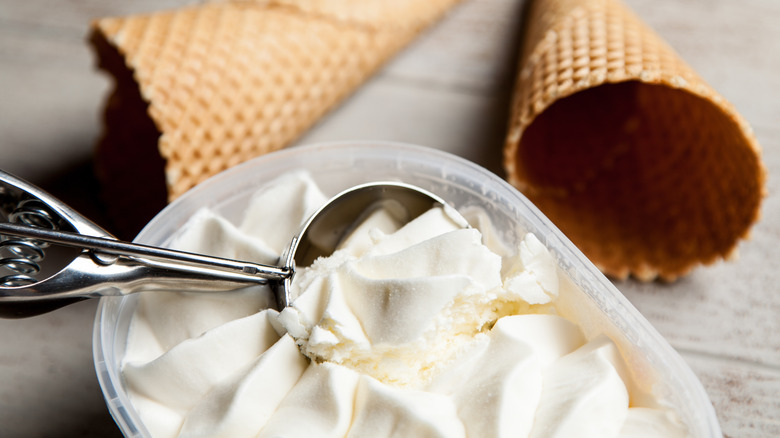Is It Safe To Eat Two-Year-Old Ice Cream?
What mysteries lie in the icy depths of your freezer? There is, beyond the outer layer of tater tots, baby peas, and Otter Pops, a midnight zone of forgotten foods, a place where the light of the bulb seldom penetrates and long forgotten foods wait. A TV dinner ages in place, its brownie never to be warmed. The ice crystals on a container of years-old lentil soup spread. A pint of two-year-old cookie dough ice cream waits in a paperboard coffin.
But wait, unlike the others, ice cream is seemingly in its element; it's meant to remain icy cold. So, you salvage it from the depths and pry off the lid like Howard Carter unsealing the sarcophagus of Tutankhamen. A layer of frosty moisture stolen from the air inside is diaphanous in the 80-watt light of your kitchen.
After procuring a spoon from the drawer, you strike the surface, creating only a dent. Stubborn and hungry, you put your shoulder into the task and pry loose a spoonful, then another. But, as you stand there waiting for the ice cream to soften to your liking, a thought crosses your mind: Is it safe to eat two-year-old ice cream?
How cold is cold enough?
There's a lot to dig into here (pun intended.) One misconception surrounding freezers is that they lock food into some sort of stasis whereby it is safeguarded indefinitely from agents of spoilage. In actuality, freezing only slows the growth of microorganisms and the action of enzymes that lead to spoilage, according to the European Food Information Council (EUFIC). This is accomplished by cutting off the supply of water by converting it from liquid to solid. What freezing does not do is kill the microorganisms. Additionally, the National Center for Home Food Preservation points out that when a food item is removed from the freezer, those microbes begin to reproduce rapidly.
Knowing that, it is important to make sure that ice cream remains as cold as possible to stave off unwanted bacterial activity. Make sure that ice cream — and other food bound for the freezer and fridge — are some of the last items you get in your cart at the grocery store, says the Michigan State University College of Agriculture and Natural Resources Extension. If possible, pack them in insulated bags alongside ice packs to keep them cold during transport. Once home, make sure your refrigerator and freezer are set to the correct temperatures. The FDA recommends a chilly 40 degrees F for the fridge and an icy 0 degrees F for the freezer.
To eat or not to eat?
Back to the question at hand: to eat or not eat your aged ice cream? The likely answer is no. Eclipse Foods explains that the ice cream in opened containers is fresh for approximately six weeks. Unopened, the freshness may extend three to four months.
Remember when we said freezing only slows the growth of microorganisms? Alas, nothing can forestall the passage of time, and eventually they will multiply in numbers that mean your ice cream's days are numbered (via Kitchen Sanity). An indicator that your ice cream is past its prime — though not a product of actual bacterial growth — is the presence of ice crystals on the packaging or on the exposed portions of the ice cream. Their formation is a good sign that enough time has passed for sufficient amounts of bacterial activity to have occurred to spoil the ice cream below. Another good indicator, according to Home Cook Basics, is the texture of the ice cream itself: If it is slimy or gooey, toss it and grab a fresh tub.
If you want to keep ice cream fresh longer, store it in the coldest part of the freezer where it has less of a chance to vary in temperature. Splendid Table points to the rear of the centermost shelf as the best place for items that need constant cold. Or, just do what we do, and eat it ASAP and move on to a fresh tub or pint.


